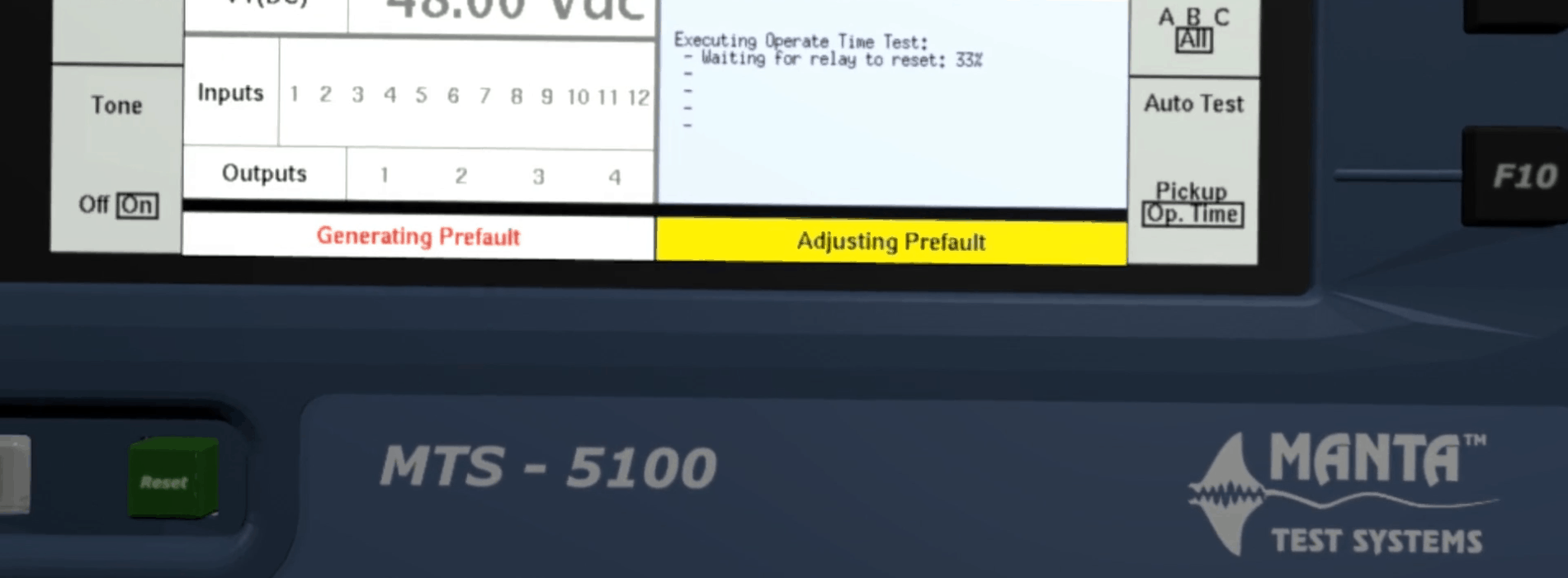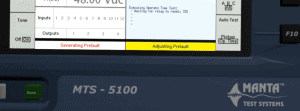Testing the SEL 311C Ground Distance Quadrilateral Element
Introduction
These instructions will allow the user to calculate the shape of the SEL 311C ground quadrilateral element and easily determine test points.
The tester will need to be able to do vector math (addition, multiplication and division) and basic trigonometry (Sin, Cos and Tan). It is recommend that the tester either purchase a calculator that is capable of performing vector calculations, download a vector calculator for the computer (available for free on the web) or download an app for to a smartphone (also free).
Distance elements are designed to protect a section of power line, by detecting a fault that is within its zone of protection. The relay will measure the voltage and current, then calculate the impedance (by dividing voltage by current). Ideally, impedance is perfectly proportional along the line. If the line is 100 miles long and the total impedance of the line is 100Ω, then the line has an impedance of 1Ω per mile. If you want to protect the first 80% (80 miles) of the line, then you would set the relay to trip when it measures an impedance of 80Ω or less.
The protected line’s impedance (and consequently the protection zone) is plotted on an impedance plane, otherwise known as an R-X diagram. The resistive portion of the impedance is on the horizontal axis, while the reactive is on the vertical, with Inductance being positive and capacitance being negative. The resistive axis is referred to as R, while the reactive axis is X.
Impedance Plane
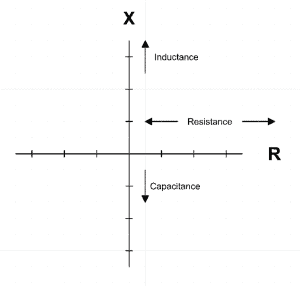
The following values are required to determine the shape of the quad. It is ALWAYS recommended that settings are taken from a settings sheet or other design basis document rather than downloading them from the relay. This ensures the tester is checking that the correct settings are in the relay in addition to the relay’s proper operation.
SEL 311C has three independent distance functions or zones. These zones are independently set to cover different lengths (impedance) and directions (forward or reverse, relative to the breaker). This paper uses the SEL zone 1 settings to illustrate the concepts, unless indicated otherwise.
Ground Distance Quad Settings and Example Values
| Setting Name | Description | Example Value |
| Z1MAG | Positive Sequence Impedance Mag. | 10 |
| Z1ANG | Positive Sequence Impedance Ang. | 83 |
| Z0MAG | Zero Sequence Impedance Mag. | 30 |
| Z0ANG | Zero Sequence Impedance Ang. | 80 |
| TANG* | Rotates top of protection zone. | -3 |
| KoM1 | Zero Sequence Compensation Factor Mag. | .67 |
| KoA1 | Zero Sequence Compensation Factor Ang. | -4.5 |
| EADVS* | Advanced Settings Enabled | N |
| E21XG | Enable Quad Dist. and number of zones | 1 |
| ZX | Reactance Setting | 6.24 |
| ZR | Resistive Setting | 2.64 |
*NOTE: Enabling EADVS allows the use of custom settings that are otherwise calculated by the relay. In zone one, this allows for a TANG other then -3 and polarization voltages other than I2. See SEL-311C instruction manual for additional settings in zones 2-4
Calculating the SEL 311C Characteristic
*Note: All equations are vectors unless Trig. Functions. All relay settings are converted to vectors. For example, Z1Mag and Z1 Angle are now referred to as Z1MAG∠Z1ANG or 10∠83°
Ground distance elements are designed to operate on ground currents. However, under ground fault conditions, there is a portion of the fault current flowing through the unfaulted conductors, which has to be compensated for. The “K factor” is used to adjust the characteristic, making the element more sensitive to overcome conductor fault currents.
With ADVS set to auto, the relay will automatically calculate k0 (Zero Sequence Compensation Factor) using the following formula: k0 = (Z0-Z1) / (3 × Z1) = (30∠80 – 10∠83) / (3 × 10∠83) = .67∠-4.5 and the “K factor” = 1 + k0 = 1 + .67 ∠-4.5 = 1.67∠-4.5
The easiest way to understand the ground quad characteristic and the R-X diagram is to think of it as a model of the power line. The line has an impedance that is evenly distributed along its length. Distance protection, by its definition, wants to protect the line for a given amount of that distance. The characteristic drawn on the R-X diagram is nothing more than a graph of the protected zone, represented in impedance, with resistance on the “R” axis and reactance on the “X” axis. Care should be taken in understanding these axes. In high school math, the X axis is almost always shown as the horizontal axis of the graph. On an R-X diagram, it is the VERTICAL axis.
In the 311C, no setting directly translates to a shape on the characteristic, it has to be calculated. This blog will graphically demonstrate how these calculations are made in order to aid the technician in determining the characteristic and hence the test points.
Starting Out
The first step is to calculate the uncompensated characteristic. The 311C does not have this vector entered directly, rather it is based on Z1ANG and ZX. Plot a line on the R-X diagram that runs from the origin to the RX value and has an angle of Z1ANG.
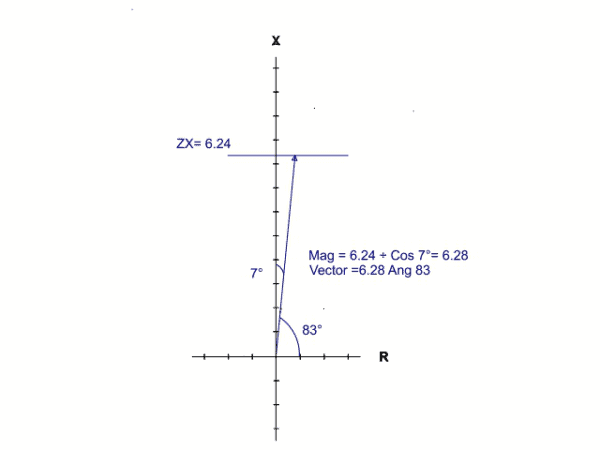
The magnitude of the vector can be calculated by dividing ZX by the Cosine (90-ANGZ1) or 6.24 ÷ Cos (7°) =6.28. Seeing that the angle does not change, the vector becomes 6.28∠83°.
Next comes applying the K factor of 1.67∠-4.5. Uncompensated Vector × K factor = 1.67∠-4.5 × 6.28∠83° = 10.49∠78.5°
This vector is the model of the power line. Its angle is traditionally called the Maximum Torque Angle (MTA).
While still widely used today, the term originates from the use of electromechanical relays. It refers to the measured impedance angle that would generate the most torque on the induction disk, which in turn would make it spin the fastest.
The length of the vector is referred to as the Reach, which “how far” the relay protects down the power line.
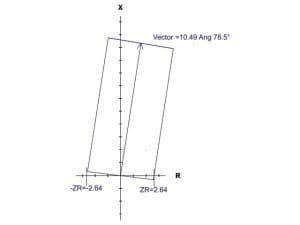
To complete the initial shape, draw a perpendicular line to the vector, running through the origin. Draw a horizontal line at the ZX value. Then draw two lines that are parallel to the vector, one running through ZR and the other running through –ZR.
The top of the characteristic is further adjusted via the “Non-homogenous Correction Angle” (setting TANG). This angle will rotate the top line to increase reach on one side of the Reach vector while lowering it on the other. Unless the EADVS setting is turned on, TANG is -3°.
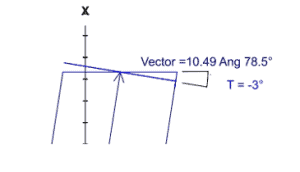
Which results in the final characteristic shape.
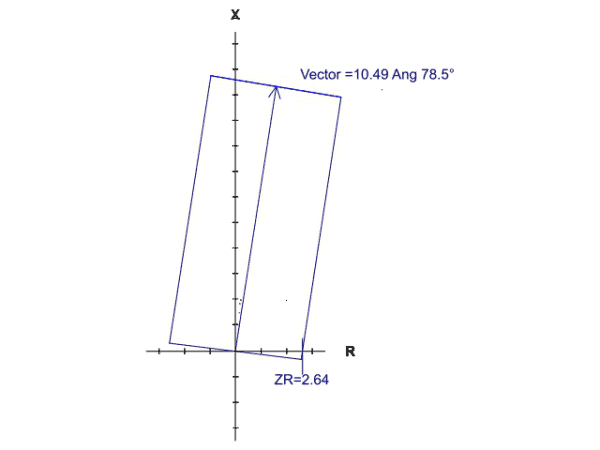
Currents and voltages are entered into a test set in vector form, hence calculating the vectors of the corners of the characteristic is necessary.
Calculating the vectors to the top corners has to take into account both TANG and the MTA. Calculating the top right corner, calculate the vector from the end of the reach vector to the corner.
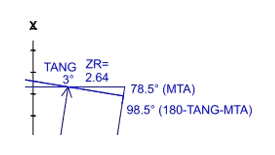
Two angles of the Triangle are known, TANG and the MTA. The third angle can be calculated by subtracting both of these from 180, resulting in the 98.5° angle.
Using the law of Sines, the magnitude of the desired vector (running from the end of the Reach to the corner of the characteristic) is calculated by Mag = Sin MTA × (ZR ÷ Sin Calculated Angle) = Sin 78.5° × (2.64 ÷ Sin 98.5°) = 2.61. The right upper corners vector can then be found by adding the Reach vector to the calculated vector, 10.49∠78.5°+ 2.61∠-3° = 11.18∠65.1° Note: The angle of the calculated vector is TANG or in this case -3°
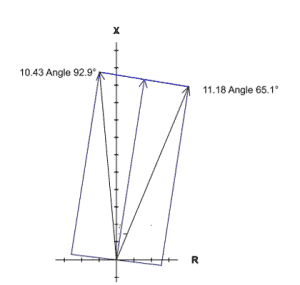
The upper left corner is calculated using the same calculated vector, but rotated 180° so that 10.49∠78.5°+ 2.61∠177° = 10.43∠92.9°
For the bottom corner vectors, the angle is found by subtracting 90° from the MTA, so the right side vector has an angle of 78.5°-90°=-11.5°. The magnitude is found by dividing RX by the COS of this angle. RX÷COS 11.5° = 2.64÷0.980=2.69. This results in a vector of 2.69∠-11.5°. The left side is the same vector rotated 180°.
Testing
There are a number of items that need to be remembered when testing the Ground Distance Quad Element in the 311C.
The first is that there is no direct Current or Voltage that can be read from the characteristic, which represents impedance. Impedance is calculated using Ohm’s law (note: all values are in vector form) V=I×R or in our case I=V÷R. Typically, the tester chooses to hold either the Voltage or Current constant and varies the other value to vary the Impedance R. In this example, we will be holding V constant while varying I to change R. The tester needs to insure that they do not pick a voltage that is so high that the test set cannot supply sufficient current to test the desired impedance. Also, ground distance protection is designed to work on single phase to ground or two phases to ground fault only. Phase distance protection protects for line to line and bolted faults.
The 311C also has a number of conditions that will block the distance element from operating. The three most common ones that affect testing are:
- Line to Line blocking. If the relay detects a line to line fault, Ground Distance protection is blocked (Phase Distance protection is expected to operate).
- VT Fuse Failure. The relay uses an algorithm to detect if a VT fuse has blown, blocking distance protection. The tester MUST remember to apply prefault voltages to prevent the Fuse Failure from asserting.
- Open Pole Detection. All three poles of the breaker must be closed for the distance element to operate.
If the tester is having an issue and suspects that the element is being blocked, it is recommended to consult the relay instruction manual’s Ground Distance Logic diagram.
It should be noted that this paper is providing the tester with the means to test points on the characteristic, it is up to the tester to determine how many of these points need to be tested for their particular application.
For this example, it is assumed that the tester wishes to test at ±5%.
Usually, the first point tested is the reach. Testing AØ phase (no other current is injected during the fault) and using fault voltages of AØ=40∠0°, BØ=120∠120° and CØ=120∠240°, the balance point would be AØ Voltage ÷ reach vector (Ohm’s Law, I=V÷R) = 40∠0° V ÷ 10.49 ∠ 78.5°. R = 3.81∠-78.5°. Testing at +5% and -5% of the vector’s magnitude, we expect the following:
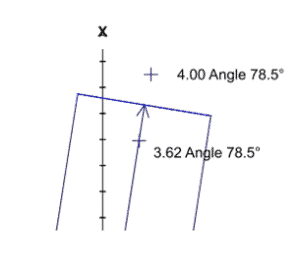
The other end of the vector can be tested in a similar way, dividing the voltage vector by the test point vector:
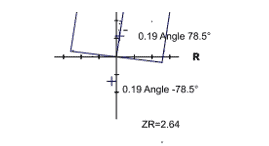
Testing the other corners of the characteristic are accomplished in the same way, with one exception. When testing at the bottom corners, the test vector is identical to the characteristic vector. In order to move your test point firmly into the operate or no operate zone, the angle of the should be rotated a few degrees in the desired direction.
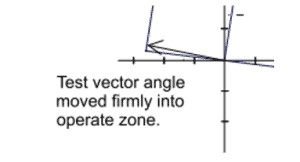
By testing the reach and the four corners, 3 points along the horizontal line have been tested, which is generally sufficient. To test a 3rd point on the vertical lines, pick a point approximately ½ way up the reach vector and add ZR at an angle of zero. Calculate the test current vector from the impedance vector in the previously described way.
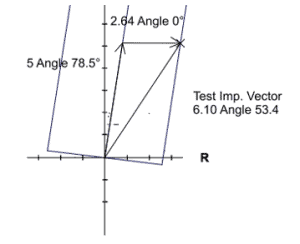
Using 40∠0° Voltage, the test current would be 6.55∠-53.4°
The left side test point is calculated by adding the ½ way vector to ZR∠180.
Conclusion
While modern test sets can make all of these calculations automatically and run an automated test, it is still important, especially for troubleshooting, to understand how both the relay and the test set calculate the values. Armed with this knowledge, the tester is better able to understand why a particular test failed and more importantly, how to fix it.

